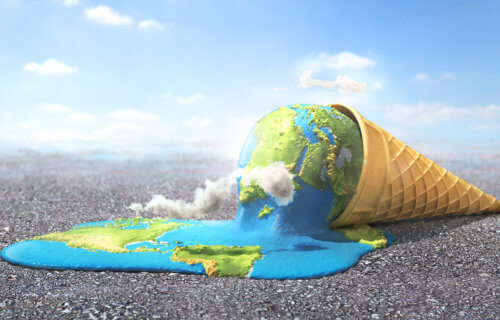UNIVERSITY PARK, Pa. – Earth’s “thermostat” appears to be slowly breaking due to climate change. However, a new study by Penn State researchers explains the best way to study this geological temperature gauge and how it’s responding to recent temperature increases. The findings may even reveal a way to reset the planet’s fragile climate.
“Life has been on this planet for billions of years, so we know Earth’s temperature has remained consistent enough for there to be liquid water and to support life,” says Susan Brantley, an Evan Pugh University professor and Barnes professor of geosciences at Penn State, in a university release. “The idea is that silicate rock weathering is this thermostat, but no one has ever really agreed on its temperature sensitivity.”
Weathering is the process of breaking down rocks and minerals on or near the Earth’s surface. A combination of the rocks, rain, and carbon dioxide involved in weathering act is similar to a thermostat regulating and maintaining Earth’s global temperature. For example, volcanic eruptions release large quantities of carbon dioxide. You would think the greenhouse gas would cause massive damage to Earth’s atmosphere, but weathering helps to remove it. Rain uses the carbon dioxide in the atmosphere to create weak acid rain that slowly erodes the surface of rocks. The remains then carry over from streams and rivers to the ocean, where sedimentary rocks lock away excess carbon.
“It has long been hypothesized that the balance between carbon dioxide entering the atmosphere from volcanoes and being pulled out by weathering over millions of years holds the temperature of the planet relatively constant,” Brantley explains. “The key is when there is more carbon dioxide in the atmosphere and the planet gets hotter, weathering goes faster and pulls more carbon dioxide out. And when the planet is cooler, weathering slows down.”
Multiple factors play a role in weathering. For example, an increase in rainwater activity can speed up the deterioration of rocks into sediments. Extreme changes in temperature are another influencer but since it’s a global phenomenon, it’s hard to predict how much it slows down or accelerates the weathering process.
“When you do experiments in the laboratory versus taking samples from soil or a river, you get different values,” says Brantley. “So what we tried to do in this research is look across those different spatial scales and figure out how we can make sense of all this data geochemists around the world been accumulating about weathering on the planet. And this study is a model for how we can do that.”
How long would it take to undo human emissions?
The research team looked at different measurements taken in the lab along with sample data from 45 different types of soil and watersheds from around the world. The collected dirt gives researchers an idea of the weathering among major rock types and a better estimate of how weathering responds to temperature.
“In a soil profile, you are seeing a picture of soil where the camera shutter was open for sometimes a million years — there are integrated processes happening for a million years and you’re trying to compare that with a two-year flask experiment,” the study author adds.
The field of critical zone science has helped with understanding the process of weathering. This involves looking at landscapes from the tallest vegetation to the deepest groundwater. One factor to consider is the size of fractures in the rock to allow cracks for water to seep through. Rocks need large, exposed surface areas to give access to water which is less likely to happen in places where the soil is deeper.
“You can measure all the rate constants you want for that solution in the lab, but until you can tell me how does surface area form out there in the natural system, you are never going to be able to predict the real system,” Bradley says.
The research findings show temperature sensitivity measurements in the lab were lower than estimates found in the samples of soil and rivers. The observations from both measurements allowed for a more accurate prediction of how much global temperatures rely on weather and how climate change impacts it.
Understanding weathering could also help with figuring out ways to enhance the process. One proposal is to dig up a lot of rock, grinding it up, and transport it to fields to increase the chances of weathering. The only caveat is that it’s a slow process and it would still take hundreds of thousands of years to undo all the carbon dioxide humankind has released into the atmosphere.
The study is published in the journal Science.

